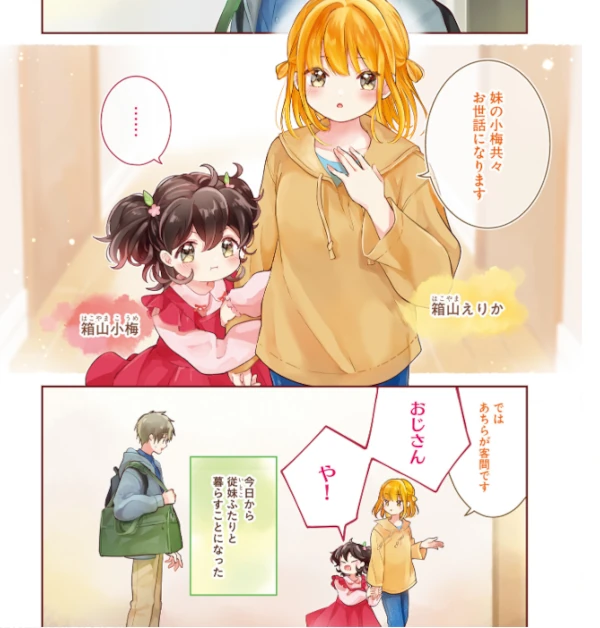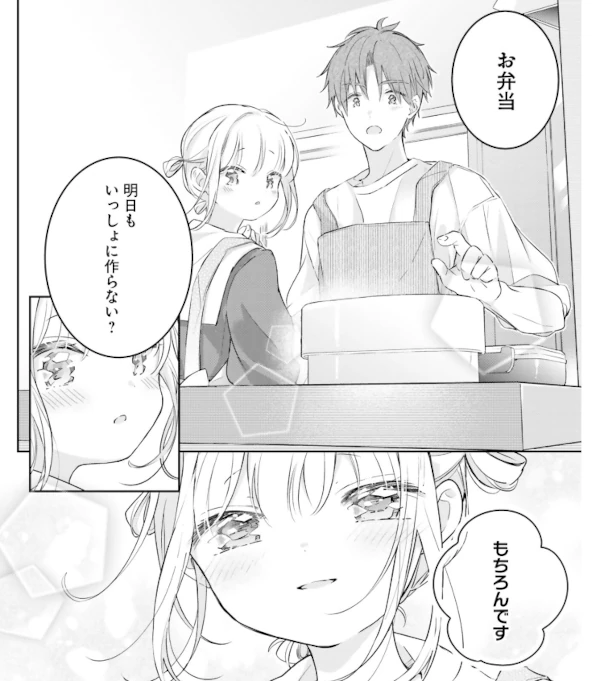This time, we’re introducing Sanshoku Bento—a gentle, food-filled slice-of-life manga that’s ideal for learning natural polite Japanese through everyday family conversations.
Work Information

Sanshoku Bento (さんしょく弁当)
Author: Uzuki Ai
Publisher: KADOKAWA
Amount of text: moderate
Challenge level: ★★
Latest volume : Vol.4(Jun.2025 / Ongoing)
Story overview
“Narumi-san, your cooking really tastes like Mom’s.”
Narumi, a single office worker who has been living alone for 10 years, suddenly finds himself sharing a home with his two cousins, who have lost their mother. When he learns that the sisters usually rely on delivery meals, he decides to cook for them. The dishes Narumi prepares are recipes taught to him by their late mother—meals filled with her memory and warmth.
“Would you teach me how to cook, too?”
A mother’s taste connects hearts. A heartwarming story of home-cooked meals and family bonds.
The Appeal of This Manga
This series depicts the unusual shared life of two sisters who have lost their mother—a high schooler and a kindergartner—and their single, bachelor cousin. Though awkward at first, the three gradually grow closer in a gentle, unhurried way.
The turning point for their relationship is the homemade bento featured in the title. Beyond bento, many episodes highlight different types of home cooking, making readers both emotionally engaged and, quite possibly, hungry.

Why this manga is suitable for learning Japanese
This manga is not only entertaining but also highly recommended for Japanese learners for several reasons.
Polite speech from a niece to her uncle
Erika, the older sister, consistently speaks to her uncle Sō in polite language. Normally, nieces and uncles in Japan would talk casually, but given the slightly delicate circumstances of their relationship, this respectful tone feels natural. For beginning learners of Japanese, it’s an excellent model for mastering teineigo (polite speech).

Rich vocabulary about Japanese home cooking
Cooking scenes are described in detail, giving readers a great opportunity to learn food-related vocabulary. At the end of each chapter, a recipe for the featured dish is included, so readers can even try recreating the meals in real life.

Culture Spotlight
The Enduring Appeal of Home-Cooked Meals in Japan家庭料理
In Japan today, more families have two working parents than ever before. You might expect this to mean less time for cooking at home—yet handmade bento lunches, family recipes, and home cooking culture remain incredibly popular. Social media, recipe blogs, and even printed cookbooks are full of pictures, tips, and heartwarming stories about homemade meals.
Why does the idea of 手作り (tezukuri, “handmade”) food hold such power? And how is this shaping Japanese language and culture today?

More Than Just Food: A Taste of Family Memory
However, this ideal also comes with a downside. Because handmade food is celebrated as loving and virtuous, some parents—especially mothers—feel pressured to cook from scratch every day. In online discussions, you’ll often see phrases like:
・「ちゃんと手作りしなきゃ」 – “I have to make everything properly by hand.”
・「冷凍食品ばかりでごめんね」 – “Sorry it’s all frozen food.”
This cultural expectation shows how language around food in Japan often blends personal affection with social judgment.
Cute and Creative: Charaben and Onigirazu
Modern home cooking isn’t just about tradition—it’s also about creativity and fun. Two recent trends stand out:
・キャラ弁 (kyaraben) – Bento boxes decorated as cartoon characters, animals, or famous mascots. They’re popular among parents making lunches for young kids.
・おにぎらず (onigirazu) – A new style of rice ball that’s wrapped like a sandwich, making it easier to prepare and fill with colorful ingredients.
These ideas spread rapidly through Instagram, YouTube, and cookbooks, turning everyday lunches into a form of personal expression—and even competition!
Cooking Celebrities and Social Media Influence
Another modern twist: popular “mama talents” (celebrity mothers) often share videos of themselves cooking, giving quick tips and showcasing stylish or heartwarming dishes. Their recipes frequently go viral, reinforcing the image of the perfect, loving home chef.
For many new mothers, these celebrities have become relatable role models—someone to look up to and emulate. Their posts offer practical ideas, but they also set a standard of “ideal motherhood,” inspiring admiration while sometimes adding subtle pressure to live up to that image.
What This Means for Japanese Learners
Learning about Japan’s home cooking culture helps you understand many words and expressions:
・手作り (tezukuri, handmade) vs. 出前 (demae, delivery)
・おふくろの味 (ofukuro no aji, mom’s home cooking)
・愛情弁当 (aijō bentō, a lunch made with love)
It also explains why food plays such an important role in stories, manga, and everyday conversation. When a character says, 「お母さんの味だ…」 (“It tastes like Mom’s cooking”), they’re not just talking about flavor—they’re talking about love, memory, and belonging.
A Little Warning
A gentle, peaceful world
While there are occasional misunderstandings or emotional moments, all the characters are fundamentally kind and caring. The story doesn’t feature major incidents or edgy drama, so readers looking for intense conflict may find the calm, tender atmosphere a bit too mild.

Work Information

Sanshoku Bento (さんしょく弁当)
Author: Uzuki Ai
Publisher: KADOKAWA
Amount of text: moderate
Challenge level: ★★
Latest volume : Vol.4(Jun.2025 / Ongoing)
Here’s a safe and convenient way to purchase Japanese manga.
This Blog’s ConceptIn this blog, we are introducing manga that are not only highly captivating but also ideal for Japanese language learners. Studying Japanese through manga is both fun and effective. Manga allows you to understand the subtleties of keigo (honorifics), teineigo (polite speech), and casual conversation in Japanese. We hope you find works that match your interests and use them to enhance your Japanese learning journey.